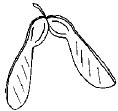

Maple Keys--The Ultimate
Helicopter
Most of us in the United States and Canada are familiar with maple trees. If you have a maple tree in your yard, you may also be familiar with the seeds that helicopter down from the trees filling gutters and generally making a mess. The next time you are inclined to say nasty things about these little irritations, take a careful look at one. The maple tree has a special need that these keys provide. To produce more maple trees the seeds have to be spread. They have to get far enough away from the tree to get adequate light so that they are not shaded by the parent. That means that as the maple key spirals down from the adult tree, it has to stay airborne for a significant period of time. The design of the maple key that allows this to happen is remarkably complex.
Take a maple key and balance it on the tip of your finger. What you
will see is that the mass of the key is concentrated in the seed and
the wing sticks out a remarkable distance. The greater area any wing
has, the more lift it has the potential to generate. You will also
notice as you look at the wing, that it is narrow near the seed and
broadens gradually until you get near the end where it tapers a bit
right near the end. As the maple key spins, the speed of the air over
its surface gets greater as you move out from the seed, so having the
blade wider further out provides a huge increase in lift. At the end of
the wing, however, you do not want a blunt surface, because small
vortexes of air would swirl around the tip producing drag which would
slow the rotation. By tapering the wing at  the tip, material
is saved and the drag is reduced.
the tip, material
is saved and the drag is reduced.
If you look carefully at the wings, you will see that they have veins in them. The veins are concentrated on the lead edge of the wing--the part that cuts into the air. This rough texture produces beneficial turbulence and the weight of the veins improves the angle of attack of the wing. We have all seen dimples on a golf ball that serve much the same purpose and know that wings of birds have the shaft on the lead edge and feathers on the back. The maple keys do not fall off the tree until the wings are quite dry, making them lighter and more brittle so that once they land the cumbersome wing material can be broken off as the seed gets imbedded in the ground.
It is easy to suggest that natural selection is the only agent here--that any other design of the wing would be less successful and thus eliminated from the population. The fact is that there is a design in the maple key that may be maintained by natural forces, but is a design nonetheless. It is the intelligence behind that design and behind the forces that keep it operative that speak eloquently of God's wisdom and creative action in the cosmos. We can know there is a God through the things He has made (Romans 1:19-22). --Data from an article by Jay Ingram in the Toronto Star, June 15, 2003, page A-14.
Back to Contents Does God Exist?, SepOct06.